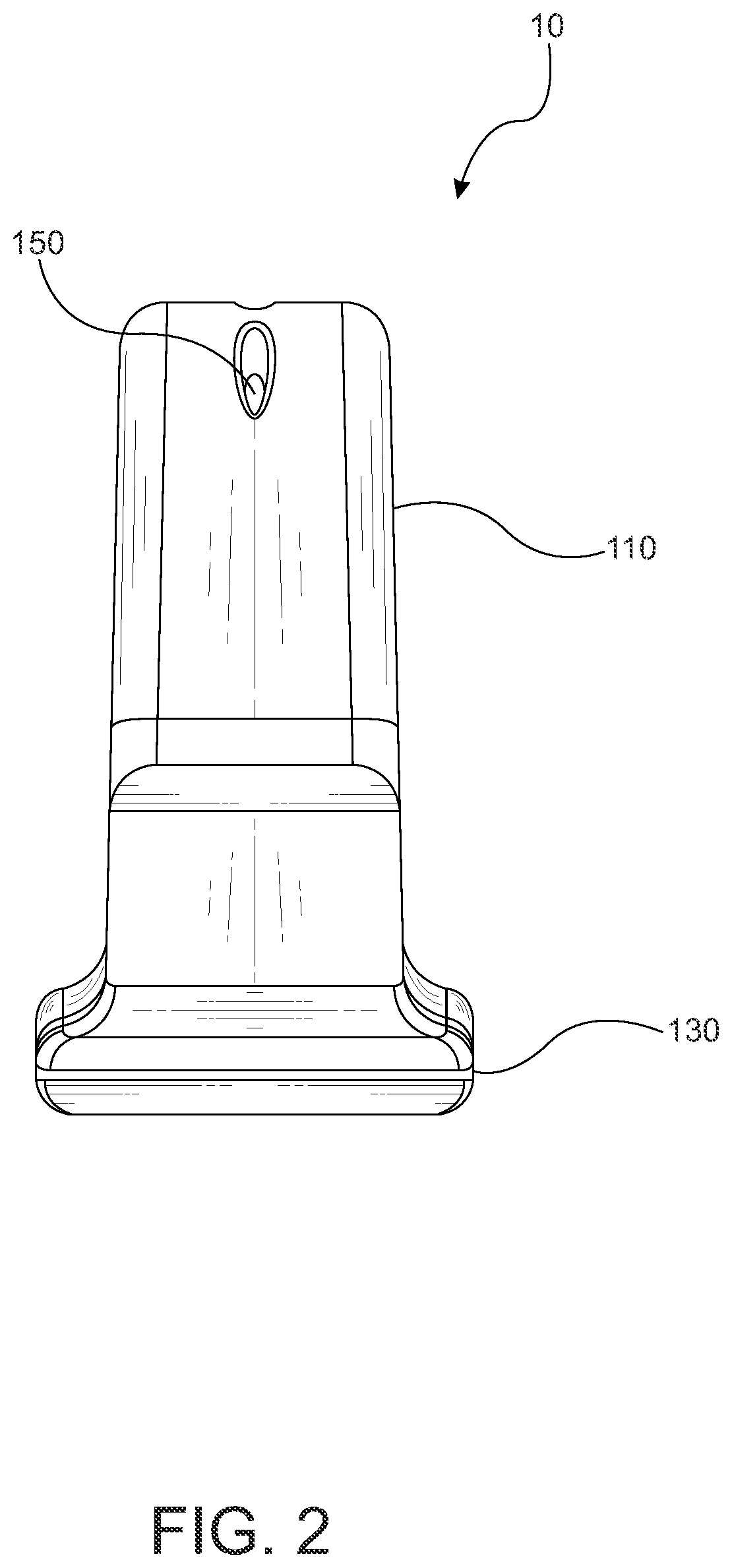Portable Oral Positive Expiratory Pressure-Generating Devices with Variable Expiratory Airflow Resistances
a positive expiratory and airflow resistance technology, applied in the direction of muscle exercise devices, gymnastic exercise, sport apparatus, etc., can solve the problems of poor exercise tolerance, reduced exercise capacity, poor quality of life (qol), etc., to prolong exhalation time, reduce respiratory rate, and facilitate conscious breathing
- Summary
- Abstract
- Description
- Claims
- Application Information
AI Technical Summary
Benefits of technology
Problems solved by technology
Method used
Image
Examples
example 1
[0059]Laryngo-pharyngeal pressures were measured at rest and during exercise in five normal subjects using different designs of the present invention with varying expiratory areas—“PEP 1” to “PEP 4.” Each grade generates different levels of PEP with the pressure increase ranging from κ to 17 cm H2O depending upon the expiratory surface area. Each PEP device 1 to 4 has a different expiratory surface area that is determined by the number of holes / slits in the device: “PEP 1” has 1 hole / slit. “PEP 2” has 2 holes / slits; “PEP 3” has 3 holes / slits; “PEP 4” has 4 holes / slits. The results are shown in FIG. 6, which shows a box-plot of the positive expiratory pressures (PEP) generated. The laryngopharyngeal pressures were measured using high-resolution esophageal manometer placed in the upper airway during restful breathing and during bicycle ergometer exercise (Ex). The pressures are near zero during normal breathing (NB) and with use of the sham device.
example 2
[0060]A 31-year-old female subject with galactosialidosis, bronchiectasis, and pan-lobular emphysema was evaluated for dyspnea and frequent exacerbations. An awake bronchoscopy demonstrated severe EDAC that was mitigated with 12 cm H2O CPAP (see Table 2).
TABLE 2Diagnostic Evaluation FindingsPulmonary Function TestForced expiratory0.71 L26% predictedvolume in 1 secForced vital capacity1.40 L44% predictedTotal lung capacity4.49 L102% predictedResidual volume3.03 L251% predictedDLCO6.57 ml / min / mm Hg29% predictedArterial blood gaspH7.46pCO232 mm HgpaO260 mm HgChest CT scan (static inspiratory and expiratory images)Severe pan-lobular emphysema. Diffusebronchial wall thickening.Greater than 50% collapse of the leftmain stem bronchus on expiration. Findingscompatible with bronchomalaciaMosaic attenuation on expiratory images,compatible with air trapping.Opacification of the left inferior lingular segmentalbronchus, with collapse andconsolidation of the posterior aspect of the lingula.Awake...
example 3
[0065]Various subjects with COPD used devices according to the present invention (PEP devices) while performing daily activities. The subjects provided the following feedback:
[0066]Subject 1: Feels that the device has been very helpful. Was excited to try the device and overdid it initially. After the first week he got a system down. He reports that once he did that, he increased his activity level. He gave an example of an activity that he does every Sunday. He has to move tables and chairs. It would normally take him 15-20 minutes to recover. With the use of the PEP device, it cut his recovery time by more than half. He reports that he can usually tell when his oxygen decreases because he gets lightheaded, and he feels it is related to his oxygen saturation. With use of PEP device, he has not felt lightheaded at all. He felt the device was very helpful and has been mentioning it to others with COPD at pulmonary rehab that he attends. Feels strongly that others should try it since ...
PUM
 Login to view more
Login to view more Abstract
Description
Claims
Application Information
 Login to view more
Login to view more - R&D Engineer
- R&D Manager
- IP Professional
- Industry Leading Data Capabilities
- Powerful AI technology
- Patent DNA Extraction
Browse by: Latest US Patents, China's latest patents, Technical Efficacy Thesaurus, Application Domain, Technology Topic.
© 2024 PatSnap. All rights reserved.Legal|Privacy policy|Modern Slavery Act Transparency Statement|Sitemap



